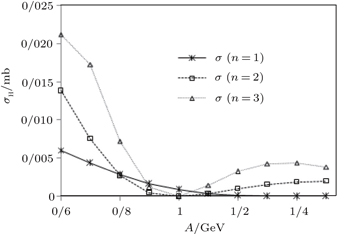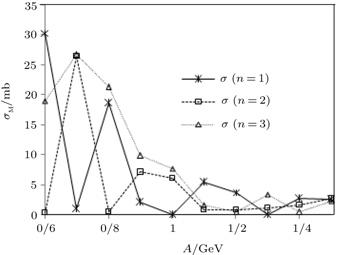† Corresponding author. E-mail:
In this paper, we study the scattering properties of s-wave Schrödinger equation for the multi-parameter potential, which can be reduced into four special cases for different values of potential parameters, i.e., Hulthén, Manning–Rosen, and Eckart potentials. We also obtain and investigate the scattering amplitudes of these special cases. Some numerical results are also obtained and reported.
One of the important tasks of non-relativistic or relativistic quantum mechanics is to study the bound states and scattering properties of a given quantum mechanical system under the action of a potential, which is very useful in studying the physical properties and handling the necessary information about the system. Recently, several authors introduced different potential models to explore the non-relativistic/relativistic bound states and scattering properties.[1–3] Aydoğdu et al.[4] derived the scattering and bound states of the Klein–Gordon equation for the Hulthén potential with unequal scalar and vector potentials and considered the position-dependent mass and constant mass, as a special case. They also calculated the transmission and reflection coefficients. In the case of unequal scalar and vector potentials, Wei et al.[5] obtained the phase shifts and normalization constant of the Klein–Gordon equation for Hulthén potential by introducing an improved new approximate scheme into the centrifugal term. The authors in Ref. [6] also reported the normalized radial wave functions and obtained the analytical formula of phase shifts within the framework of the partial-wave method, for the Schrödinger equation under the hyperbolic molecular potential. Castilho and Castro[7] investigated the scattering and bound states of fermions in a mixed vector–scalar smooth step potential. In D-dimensional space, Chen et al.[8] represented the non-relativistic scattering properties of modified Pöschl–Teller potential. They also provided some numerical results and compared them with others. In view of a spatially one-dimensional (1D) Woods–Saxon potential, the scattering solutions of the Klein–Gordon equation have been obtained in terms of hypergeometric functions by Rojas and Villalba, and they have derived the condition for the existence of transmission resonances.[9] The interested readers can also consult Refs. [10]–[12] for more information.
Recently, Garcia-Martinez[13] proposed the solvable multi-parameter exponential-type potential in the following form:

The main purpose of the present article is to report the scattering amplitude of the s-wave Schrödinger equation for the multi-parameter exponential-type potential and to discuss the special cases of the potential.
The radial Schrödinger equation has the form























In this section, we are going to study four special cases of the multi-parameter exponential-type potential and their scattering properties by choosing approximate parameters in the multi-parameter exponential-type potential.
As already mentioned, for A = −Ze2λ, α = λ, B = C = 0, the multi-parameter exponential-type potential reduces to the Hulthén potential




If we choose B = 0, A = −V0/b2, C = α′(α′ – 1)/b2, and α = 1/b, the multi-parameter exponential-type potential turns into the Manning–Rosen potential[22,23]






By considering C = 0, A = −δ, B = β, α = 1/a, the multi-parameter exponential-type potential changes into the Eckart potential






Finally, we present some figures which show the scattering cross section (σ) of multi-parameter exponential-type potential and its special cases for different states in Figs.
 | Fig. 2. Variations of scattering cross section with A for different states of Hulthén potential m = 0.938 GeV and α = 0.01 GeV. |
 | Fig. 3. Variations of scattering cross section with A for different states of Manning–Rosen potential, C = 0.0002 GeV, m = 0.938 GeV, and α = 0.01 GeV. |
 | Fig. 4. Variations of scattering cross section with A for different states of Eckart potential, m = 0.938 GeV, B = 0.2 GeV, and α = 0.01 GeV. |
It is obvious from these figures that among the special cases of the multi-parameter exponential-type potentials, the Eckart potential has made the most contributions to cross section, and the obtained values of the cross section for this potential are greater than for the Hulthén and the Manning–Rosen potentials. We can also see that in Fig.
The multi-parameter exponential-type potential provides an appealing option for theoretical physicists especially for molecular systems. As we have already mentioned, this potential can reduce to special cases of molecular potentials, therefore it can be a suitable choice to study physical systems. Because of these results and the importance of scattering properties, we investigate the scattering amplitude of the Schrödinger equation for multi-parameter exponential-type potential, and report the scattering amplitudes of the special cases. We also report some numerical results. As we see from the figures, of the three potentials (the Eckart potential, the Hulthén potential, and the Manning–Rosen potential), the Eckart potential makes the most contributions to cross section.
| 1 | |
| 2 | |
| 3 | |
| 4 | |
| 5 | |
| 6 | |
| 7 | |
| 8 | |
| 9 | |
| 10 | |
| 11 | |
| 12 | |
| 13 | |
| 14 | |
| 15 | |
| 16 | |
| 17 | |
| 18 | |
| 19 | |
| 20 | |
| 21 | |
| 22 | |
| 23 | |
| 24 | |
| 25 | |
| 26 |



